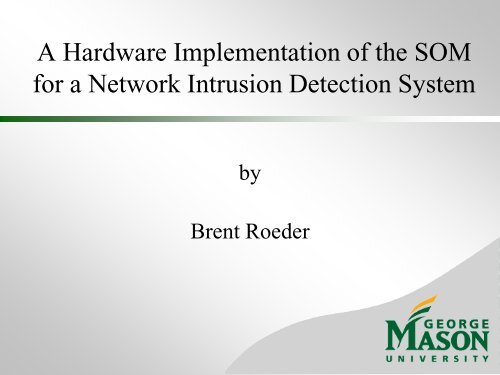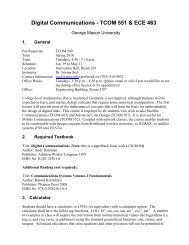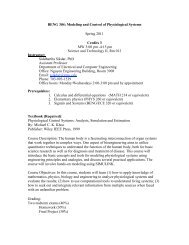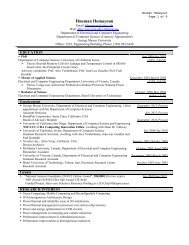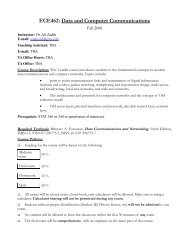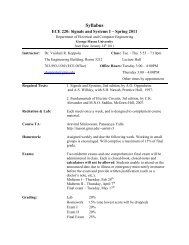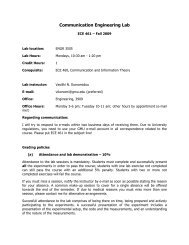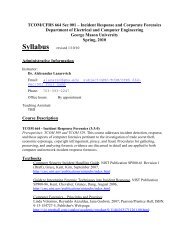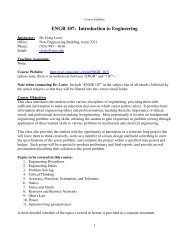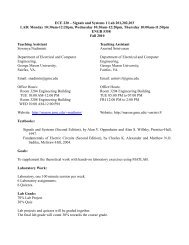Mason Template 1: Title Slide - George Mason University
Mason Template 1: Title Slide - George Mason University
Mason Template 1: Title Slide - George Mason University
You also want an ePaper? Increase the reach of your titles
YUMPU automatically turns print PDFs into web optimized ePapers that Google loves.
A Hardware Implementation of the SOM<br />
for a Network Intrusion Detection System<br />
by<br />
Brent Roeder
A Hardware Implementation of the SOM<br />
for a Network Intrusion Detection System<br />
Introduction<br />
SOM Algorithm<br />
SOM Implementation Research<br />
Port Agent SOM Implementation<br />
Port Agent SOM Design Verification<br />
Results and Analysis<br />
Future Work<br />
Summary and Conclusions
What is the significance of this<br />
Thesis?<br />
• There is a critical need for the ability to<br />
detect malicious network intrusions<br />
• A Self Organizing Map (SOM) based<br />
solution known as the port agent<br />
architecture has been proposed to solve<br />
this problem [Kohlbrenner. 2011]<br />
• A hardware implementation of the SOM is<br />
required for the port agent architecture<br />
that can process 1Gbps Ethernet traffic for<br />
anomalies
SOM Background<br />
• Unsupervised learning algorithm conceived by<br />
Teuvo Kohonen and others in the early 1980’s<br />
• Takes higher dimensional feature vectors and<br />
produces a matrix of reduced dimensionality<br />
(typically 2D) based on the similarities in the<br />
features of the input training vectors<br />
[Kohonen, 2001]
SOM Background [cont]<br />
Figure 1 SOM Concept - Source Note: [Kohlbrenner, 2011]
SOM Operation<br />
• The SOM has a training phase and then a<br />
classification phase<br />
• Training step 1: Assign random value to all of<br />
the nodes<br />
• Training step 2: A feature vector from the training<br />
data set is compared to every element in the SOM<br />
matrix using a distance metric
SOM Operation [cont]<br />
• Training step 3: The element in the matrix with the<br />
smallest computed distance to the input feature<br />
vector is selected as the best matching unit (BMU)<br />
• Training step 4: Update the BMU and all<br />
elements in its neighborhood to more closely<br />
match the input feature vector<br />
• The learning amount and neighborhood size shrink<br />
over time
SOM Operation [cont]<br />
• Training step 5: If a termination criterion is met (i.e.<br />
a sufficient number of vectors have been processed),<br />
the training is over, if not, the steps are repeated<br />
• The SOM can be used to classify data after training<br />
by presenting data to the SOM and determining the<br />
location of the BMU<br />
• The SOM can be used to detect anomalies in data by<br />
assessing the distance between the data input and the<br />
BMU
Port Agent Architecture<br />
• The port agent architecture uses a system of SOM<br />
based port agents to detect anomalous network traffic<br />
passing through the ports of an enterprise level<br />
network switch<br />
Figure 2 Port Agent Architecture - Source Note:<br />
[Kohlbrenner, 2011]
Port Agent Design<br />
• Each port agent consists of two SOMs optimized for anomaly<br />
detection and classification by preloading an already trained<br />
map and using a constant learning rate and neighborhood size<br />
Figure 3 Port Agent Design - Source Note:<br />
[Kohlbrenner, 2011]
Thesis Objective<br />
• The design modifications for the port agent SOM<br />
result in a smaller and faster SOM<br />
• The objective of this thesis is to provide a design<br />
comparison between a conventional SOM and the<br />
port agent SOM<br />
• Both designs are fully implemented and the results<br />
are used to show that the port agent SOM<br />
implementation is smaller than a conventional SOM<br />
and can process data faster
A Hardware Implementation of the SOM<br />
for a Network Intrusion Detection System<br />
Introduction<br />
SOM Algorithm<br />
SOM Implementation Research<br />
Port Agent SOM Implementation<br />
Port Agent SOM Design Verification<br />
Results and Analysis<br />
Future Work<br />
Summary and Conclusions
Step 1: SOM Initialization<br />
• Data is processed and maintained in the SOM<br />
matrix as n-dimensional vectors<br />
• Weight Vector: W j = (w 1, w 2, …, w n)<br />
• Input Vector: V i = (v 1, v 2, …, v n)<br />
• The SOM matrix is initialized by assigning a<br />
starting value to each W j in the matrix<br />
• The initial value of W j is often a random number
Step 2: Feature Vector Distance<br />
Calculation<br />
• An input vector V i = (v 1, v 2, …, v n) is presented to<br />
the SOM and compared to each of the weight vectors<br />
W j = (w 1, w 2, …, w n) in the matrix using a distance<br />
metric<br />
• A common metric used in the SOM is the Euclidean<br />
norm [Kohonen, 2001]
Step 3: BMU Selection<br />
• BMU selection is accomplished by comparing the<br />
distance computed in the previous algorithm step for<br />
each element and selecting the index of the element<br />
whose weight is the closest to the input vector<br />
• This is formalized in [Kohonen, 2001] as
Step 4: Weight Update Calculation<br />
• Based on the BMU selected and the input feature vector V i,<br />
each element in the SOM is updated<br />
• The amount an element is updated is calculated as a function<br />
of the discrete time coordinate t as<br />
• t is incremented for every input vector processed
Step 4: Weight Update Calculation<br />
[cont]<br />
• h cj(t) is referred to as the neighborhood kernel and is typically computed as<br />
a Gaussian function [Kohonen, 2001] or a step function [Pena, 2004]<br />
• Gaussian function<br />
• λ(t) is the learning rate and is a monotonically decreasing function of time<br />
• ||r j – r c|| is the distance between the element to be updated and the best<br />
matching unit<br />
• σ(t) is the neighborhood width and is a monotonically decreasing function<br />
of time
Step 4: Weight Update Calculation<br />
[cont]<br />
• Step function<br />
• N c(t) is a set of points within a boundary centered at the BMU c, and a<br />
radius r = σ(t), calculated as a monotonically decreasing function of time
BMU Neighborhood<br />
Figure 4 BMU Neighborhood
A Hardware Implementation of the SOM<br />
for a Network Intrusion Detection System<br />
Introduction<br />
SOM Algorithm<br />
SOM Implementation Research<br />
Port Agent SOM Implementation<br />
Port Agent SOM Design Verification<br />
Results and Analysis<br />
Future Work<br />
Summary and Conclusions
Overview<br />
• Researched previous hardware<br />
implementations in order to understand the<br />
design tradeoffs<br />
• Categorized implementations based on their<br />
matrix topology, distance metric, BMU<br />
selection, and weight update function
Matrix Topology<br />
• Interconnected nodes vs. Independent nodes<br />
Figure 5 Interconnected Topology (left), Independent Topology (right)<br />
• Interconnected topology requires more<br />
hardware [Melton, 1992]
Distance Metric<br />
• Euclidean Norm<br />
• Manhattan Distance<br />
• Hamming Distance<br />
• Chess Book Norm
BMU Selection<br />
• BMU selection requires the implementation of<br />
a search algorithm to select the SOM node<br />
whose weight vector is the smallest distance<br />
from the input vector<br />
• The binary tree search and the bit serial search<br />
were encountered most often
BMU Selection: Binary Tree<br />
Search<br />
• Efficient for small maps, long path delay for<br />
large maps<br />
Figure 6 Binary Tree Search – Source<br />
Note: [Pena, 2004]
BMU Selection: Bit Serial Search<br />
• Compares the MSB for every element in parallel<br />
to determine which is the smallest<br />
Figure 6 Bit Serial Search
Weight Update Function<br />
• Similar to the distance metric, the weight update<br />
function is often simplified for hardware<br />
implementations to eliminate the required<br />
multiplication<br />
• The solution encountered most often was the<br />
replacement of h cj(t) with a negative power of two<br />
which removes the need for a hardware multiplier
A Hardware Implementation of the SOM<br />
for a Network Intrusion Detection System<br />
Introduction<br />
SOM Algorithm<br />
SOM Implementation Research<br />
Port Agent SOM Implementation<br />
Port Agent SOM Design Verification<br />
Results and Analysis<br />
Future Work<br />
Summary and Conclusions
Design Approach<br />
• The approach used was to develop a fully<br />
featured conventional SOM and then<br />
optimize this design for minimal size and<br />
maximum throughput for the port agent<br />
SOM<br />
• This was accomplished by simplifying or<br />
altogether removing elements of the<br />
conventional SOM not required by the port<br />
agent SOM
SOM Requirements<br />
• Size: 256 Nodes<br />
• 16 nodes x 16 nodes<br />
• Feature Vectors: 64 bits<br />
• 8 x 8-bits<br />
• Throughput: 2,976,190 vectors/second<br />
[Kohlbrenner, 2011]<br />
• Based on 1 Gbps Ethernet traffic
SOM Architecture<br />
• Topology: Fixed architecture of<br />
independent nodes that can process each<br />
input vector in parallel to maximize<br />
throughput<br />
• Distance Metric: Manhattan<br />
• BMU Selection: Bit serial search<br />
• Weight Update: Negative power of two
SOM Architecture [cont]<br />
Figure 7 SOM Hardware Architecture
Conventional SOM Datapath<br />
• The datapath contains all of the processing elements of the SOM, the<br />
winner take all (WTA) BMU selection circuit, and the parameter scheduler<br />
Figure 10 Datapath
Conventional SOM Weight Update<br />
Logic<br />
Figure 12 Weight Update Logic<br />
• Weight update function<br />
• Implements negative power of two<br />
h cj(t) from [Pena, 2004]<br />
• D(R j,R j*) is the Manhattan distance<br />
between the BMU j* and the node<br />
being updated, j<br />
• h cj(t) decreases over time with<br />
increasing α and β
Conventional SOM Distance<br />
Calculation Logic<br />
Figure 13 Distance Calculation Logic<br />
• Calculates the Manhattan distance<br />
between the input vector and the weight<br />
vector<br />
• The distance is stored in a Parallel In<br />
Shift Out (PISO) register to be<br />
processed by the WTA BMU selection<br />
logic
Conventional SOM WTA Circuit<br />
Figure 14 WTA BMU Selection Logic<br />
• WTA circuit<br />
selects the BMU<br />
• Requires 11<br />
clock cycles to<br />
compare all<br />
MSBs<br />
• Requires up to<br />
256 clock cycles<br />
to randomly<br />
break ties
Port Agent SOM Overview<br />
• The port agent SOM is a modified version of the conventional SOM that has been optimized<br />
for area and speed by simplifying the weight update logic<br />
• The port agent SOM is loaded with an already trained map eliminating the need a<br />
monotonically decreasing neighborhood function<br />
• h cj(t) for the port agent SOM is derived from the conventional SOM by assuming<br />
the maximum values of α = 2, β = 3, and D(R j,R j*) = 1<br />
• Removal of α and β eliminates the need for a parameter scheduler<br />
• Reduces the complexity of the weight update logic
Conventional SOM Weight Update<br />
Logic<br />
Figure 16 Weight Update Logic for Conventional SOM (left) Port Agent SOM<br />
(right)
Port Agent SOM Datapath<br />
Figure 17 Datapath/Controller (top) and Datapath (bottom)<br />
• The port agent SOM<br />
requires less signaling<br />
between the datapath<br />
and controller because<br />
of the removal of the<br />
parameter scheduler
A Hardware Implementation of the SOM<br />
for a Network Intrusion Detection System<br />
Introduction<br />
SOM Algorithm<br />
SOM Implementation Research<br />
Port Agent SOM Implementation<br />
Port Agent SOM Design Verification<br />
Results and Analysis<br />
Future Work<br />
Summary and Conclusions
Overview<br />
• Validation was accomplished by implementing the SOM in VHDL and verifying<br />
through simulation using Aldec Active-HDL 8.3 SP1<br />
• SOM matrix was preloaded with a map generated using the software implementation<br />
from [Kohlbrenner, 2011]<br />
• Three test vectors were selected to test the three neighborhood scenarios possible in<br />
the port agent SOM<br />
• Results were compared to a software implementation of the weight update function<br />
Figure 19 Port Agent SOM Test Case 1 (left), 2 (middle), and 3 (right)
A Hardware Implementation of the SOM<br />
for a Network Intrusion Detection System<br />
Introduction<br />
SOM Algorithm<br />
SOM Implementation Research<br />
Port Agent SOM Implementation<br />
Port Agent SOM Design Verification<br />
Results and Analysis<br />
Future Work<br />
Summary and Conclusions
Overview<br />
• Both the conventional SOM and port agent<br />
SOM were targeted for the Xilinx Virtex-6<br />
xc6v1x760 and Altera Stratix IV GT<br />
ep4s100g4f45i1 FPGA parts<br />
• Xilinx ISE version 12.4 was used for the<br />
Virtex-6 implementation<br />
• Altera Quartus II – 10.1 was used for the<br />
Stratix IV implementation<br />
• The Automated Tool for Hardware EvaluatioN<br />
(ATHENa) version 0.6.1 [Gaj, 2010]
Virtex-6 Results<br />
Table 4 Minimum Area Implementation for the Virtex-6<br />
Table 5 Maximum Throughput Implementation for the Virtex-6
Stratix IV Results<br />
Table 6 Minimum Area Implementation for the Stratix IV<br />
Table 7 Maximum Throughput Implementation for the Stratix IV
Analysis<br />
• The port agent SOM is more than two times as fast<br />
and less than ¼ the size of the conventional SOM on<br />
the Virtex-6<br />
• The port agent SOM is more than 30% faster and less<br />
than ¼ the size of the conventional SOM on the Stratix<br />
IV<br />
• Small improvements in size to each node is magnified<br />
since there are 256 nodes in the design
Analysis [cont]<br />
• The port agent SOM latency for each<br />
vector on Virtex-6 is 1,349 ns<br />
• This equates to 741,549 vectors/second<br />
• The port agent SOM latency for each<br />
vector on the Stratix IV is 887 ns<br />
• This equates to 1,127,464 vectors/second
Analysis [cont]<br />
• Software implementation was evaluated on a Linux Fedora<br />
Core 13 Virtual Machine (VM)<br />
• Eight Core Dell T7400 with 6GB of memory<br />
The VM was configured to have two CPUs and 2GB of memory<br />
• Each CPU in the VM was a four core E4520 running at 2.5 GHz<br />
• The software port agent SOM was able to process 71,942<br />
vectors/second<br />
• Port agent SOM hardware implementation is more than 10<br />
times faster than a functionally equivalent software<br />
implementation from [Kohlbrenner, 2011]
A Hardware Implementation of the SOM<br />
for a Network Intrusion Detection System<br />
Introduction<br />
SOM Algorithm<br />
SOM Implementation Research<br />
Port Agent SOM Implementation<br />
Port Agent SOM Design Verification<br />
Results and Analysis<br />
Future Work<br />
Summary and Conclusions
BMU Selection Time<br />
• The port agent SOM as implemented fails to process the<br />
2,976,190 vectors/second required for 1 Gbps Ethernet traffic<br />
• This is largely because of the 128 clock cycles required by<br />
the BMU search circuit to randomly choose a BMU<br />
Figure 24 BMU Search Circuit
BMU Selection Time [cont]<br />
• The BMU search circuit can be clocked faster than the rest of<br />
the port agent SOM<br />
• Static timing analysis has demonstrated that the BMU search<br />
circuit can be clocked at 517 MHz on the Virtex-6<br />
• At this clock rate the average time required to process an input<br />
vector would be reduced from 1349 ns to 381 ns on the Virtex-6<br />
• Assuming the Stratix IV supports this rate, the time to process<br />
an input vector is reduced from 887 ns to 385 ns or 2,985,074<br />
vectors/second<br />
• This would be sufficient for processing 1 Gbps traffic
Initial Matrix Weight<br />
Configuration<br />
• The port agent SOM as designed is preloaded with<br />
hard coded pre-trained initial weights<br />
• The port agent SOM requires the ability to be<br />
preloaded with a user configurable set of values<br />
during periodic system maintenance<br />
• I/O ports and the associated control logic must be<br />
added in the future to support this requirement
A Hardware Implementation of the SOM<br />
for a Network Intrusion Detection System<br />
Introduction<br />
SOM Algorithm<br />
SOM Implementation Research<br />
Port Agent SOM Implementation<br />
Port Agent SOM Design Verification<br />
Results and Analysis<br />
Future Work<br />
Summary and Conclusions
Summary and Conclusions<br />
• The research and development of a hardware implementation of the SOM for a network<br />
intrusion detection system was described<br />
• A survey of conventional SOM implementations in hardware resulted in the design of a<br />
conventional SOM<br />
• The conventional SOM was modified for use as a detector of anomalous network traffic<br />
• The resulting implementation known as the port agent SOM was validated with software<br />
and fully implemented on the Virtex-6 and Stratix IV FPGA devices<br />
• The port agent SOM is more than two times as fast and less than ¼ the size of the<br />
conventional SOM on the Virtex-6<br />
• The port agent SOM is more than 30% faster and less than ¼ the size of the conventional<br />
SOM on the Stratix IV<br />
• The hardware implementation of the port agent SOM is 10 times as fast as the software<br />
implementation<br />
• By adding a separate clock for the BMU search circuit that port agent<br />
SOM will be able to support 1 Gbps Ethernet traffic as desired
A Hardware Implementation of the SOM<br />
for a Network Intrusion Detection System<br />
References
References<br />
[Kohlbrenner, 2011] P. Kohlbrenner, B. Roeder, K. Gaj, “Design of a Self Organizing Map (SOM)<br />
Based Anomaly Detector for Distributed Network Intrusion Detection,”<br />
Technical Report, <strong>George</strong> <strong>Mason</strong> <strong>University</strong>, 2001.<br />
[Kohonen, 2011] T. Kohonen, Self-Organizing Maps, New York: Springer, 2001.<br />
[Kohlbrenner, 2011] P. Kohlbrenner, “Self Organized Maps Verses Off-line Discord Detection for<br />
Network Intrusion Detection,” CS 795 Project Report, <strong>George</strong> <strong>Mason</strong><br />
<strong>University</strong>, 2011.<br />
[Pena, 2004] J. Pena, M. Vanegas, A. Valencia, “Parallel FPGA implementation of selforganizing<br />
maps,” Microelectronics, 2004. ICM 2004 Proceedings. The 16th<br />
International Conference on, vol., no., pp. 709- 712, 6-8 Dec. 2004.
References [cont]<br />
[Khalifa, 2004] K. Khalifa, B. Girau, F. Alexandre, and M.H. Bedoui, “Parallel FPGA<br />
implementation of self-organizing maps,” Microelectronics, 2004. ICM 2004<br />
Proceedings. The 16th International Conference on, vol., no., pp. 709- 712,<br />
6-8 Dec. 2004.<br />
[Hochet, 1990] B. Hochet, V. Peiris, G. Corbaz, M. Declercq, “Implementation of a neuron<br />
dedicated to Kohonen maps with learning capabilities,” Custom Integrated<br />
Circuits Conference, 1990., Proceedings of the IEEE 1990 , vol., no.,<br />
pp.26.1/1-26.1/4, 13-16 May 1990.<br />
[Macq, 1993] D. Macq, M. Verleysen, P. Jespers, J. Didier-Legat, “Analog implementation<br />
of a Kohonen map with on-chip learning,” Neural Networks, IEEE<br />
Transactions on , vol.4, no.3, pp.456-461, May 1993.
References [cont]<br />
[Melton, 1992] M. Melton, T. Phan, D. Reeves, D. Van den Bout, “The TInMANN VLSI<br />
chip,” Neural Networks, IEEE Transactions on , vol.3, no.3, pp.375-384,<br />
May 1992.<br />
[Ienne, 1994] P. Ienne, M. Viredaz,, “Implementation of Kohonen's self-organizing<br />
maps on MANTRA I,” Microelectronics for Neural Networks and Fuzzy<br />
Systems, 1994., Proceedings of the Fourth International Conference on,<br />
vol., no., pp.273-279, 26-28 Sep 1994.<br />
[Perez, 1995] M. Perez, W. Luque, F. Damiani, “Design of a 4×4 Kohonen neural net-<br />
VHDL description,” Devices, Circuits and Systems, 1995. Proceedings of<br />
the 1995 First IEEE International Caracas Conference on, vol., no.,<br />
pp.135-138, 12-14 Dec 1995.
References [cont]<br />
[Appiah, 2009] K. Appiah, A. Hunter, M. Hongying, Y. Shigang, M. Hobden, N.<br />
Priestley,P. Hobden, C. Pettit, “A binary Self-Organizing Map and its<br />
FPGA implementation,” Neural Networks, 2009. IJCNN 2009.<br />
International Joint Conference on , vol., no., pp.164-171, 14-19 June<br />
2009.<br />
[Porrmann, 2003] M. Porrmann, U. Witkowski, U. Ruckert, “A massively parallel<br />
architecture for self-organizing feature maps,” Neural Networks, IEEE<br />
Transactions on, vol.14, no.5, pp. 1110- 1121, Sept. 2003.<br />
[Onodera, 1990] H. Onodera, K. Takeshita, K. Tamaru, "Hardware architecture for<br />
Kohonen network," Circuits and Systems, 1990., IEEE International<br />
Symposium on, vol., no., pp.1073-1077 vol.2, 1-3 May 1990.
References [cont]<br />
[Rajah, 2004] A. Rajah, M. Khalil Hani, "ASIC design of a Kohonen neural network<br />
microchip," Semiconductor Electronics, 2004. ICSE 2004. IEEE<br />
International Conference on, vol., no., pp. 4 pp., 7-9 Dec. 2004.<br />
[Tisan, 2008] A. Tisan, S. Oniga, C. Gavrincea, A. Buchman, "FPGA implementation<br />
of a self-organized map with on-chip learning," Optimization of<br />
Electrical and Electronic Equipment, 2008. OPTIM 2008. 11th<br />
International Conference on, vol., no., pp.81-86, 22-24 May 2008.
References [cont]<br />
[Gaj, 2010] K. Gaj, J.P. Kaps, V. Amirineni, M. Rogawski, E. Homsirikamol, B.Y.<br />
Brewster, “ATHENa – Automated Tool for Hardware EvaluatioN:<br />
Toward Fair and Comprehensive Benchmarking of Cryptographic<br />
Hardware using FPGAs,” 20th International Conference on Field<br />
Programmable Logic and Applications, Milano, Italy, Aug. 31st - Sep.<br />
2nd, 2010.


